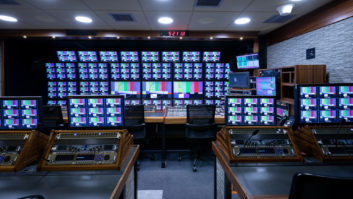In recent months, huge pressure and demands have been heaped on the media and broadcast industry, exacerbating an already precarious situation for many organisations. As an industry we have found ourselves in a paradox; live production of content limited, by government restrictions, just at a time when more people are at home, increasing content demand more than ever. It has been incredible being part of and watching an industry overcoming such obstacles, coupled with creativity and tenacity that quickly saw some pivot to new ways of working, such as remote production.
 Such was the time, following events in the US, the world has been gripped by movements inspired by Black Lives Matter to drive change – not just in a single industry but across society. It’s forced all sectors to look within, to see how improved inclusion can be brought about; which has resulted in a number of initiatives and pledges by the media industry, that can be truly transformational over the coming years.
Such was the time, following events in the US, the world has been gripped by movements inspired by Black Lives Matter to drive change – not just in a single industry but across society. It’s forced all sectors to look within, to see how improved inclusion can be brought about; which has resulted in a number of initiatives and pledges by the media industry, that can be truly transformational over the coming years.
2020 is viewed as a year of challenge, which is most definitely has been, but progress in the two areas of sustainability – environmental and diversity – provide an early blueprint for hope.
The road to more sustainable broadcasting
Transport is responsible for nearly 30 per cent of the EU’s total CO2 emissions, of which 72 per cent comes from road transportation. As such, many industries look at lowering road use to reduce carbon footprints, and broadcasting is no different – it just required a new way of thinking and working. That opportunity came with the government restrictions around the pandemic preventing traditional broadcasting activities and processes, so it was time to find another way.
Project Restart became the perfect catalyst to start to address the issue. Pre-pandemic, broadcasting live sporting events could mean travel for around six people who would set up in a production van (which also has to be driven), two more people setting up the plug-and-play fibre, and all the broadcasters.
With remarkable industry collaboration, it was proven that fewer individuals are needed to be physically present in production or outside broadcast vans. Instead, seamless network connectivity that connects producers, editors and other individuals who were now working remotely; workflows were being redesigned and becoming a new foundation. The quality of the content produced revealed that remote working is a viable option when underpinned by top-tier network solutions, which can bring jobs and opportunities to locations local to the many.
Project Restart was the leap of faith needed. With far fewer vehicles required, it is a referenceable example of a sustainable initiative that can go a long way to achieving the government’s goal of net zero carbon emissions by 2050. Within the media industry, organisations can do their bit by being a part of and wholly committing to initiatives such as the DPP’s sustainability programme. The programme provides practical tools for organisations to gain a better understanding and demonstrate a commitment to continuous improvement.
As we all watched our television or other devices more closely, something else was happening – an increasing democratisation of production, with many more diverse faces appearing and producing content. A benefit of more flexible working that helped springboard the next important step in sustainability: diversity and inclusion.
- albert celebrates class of 2020
- ITV’s regional news achieves albert certification
- albert to explore impact of sports broadcasting on the environment
Strength lies in differences, not similarities
Recent movements in racial and gender equality has sparked entire nations into action and the media and broadcasting industry is responding in kind. Change needed to happen; according to Ofcom’s Diversity and Equal Opportunities in Television report, evidence suggests too many people of differing backgrounds are excluded from working in the industry. The proportion of women in senior television roles is significantly lower than men, the representation of disability has not improved and employees from BAME backgrounds remain under-represented at senior levels.
The increased focus on the news led to many commitments across the industry, such as those from SKY, ITV, BBC and BT Sport – all pledging public ambitions to diversify not only the workforce, but also those visible on television.
New ways of working gives employers access to the best talent in the world and opens up jobs to candidates of all classes and backgrounds – regardless of demographics, whether they have to stay at home for childcare or if they have a disability that makes it difficult to travel. Moving forward, with the increased convergence of broadcast and IT engineering, more flexible and variable workflows should in turn accelerate the diversification of the workforce.
What does this mean for the media and broadcast industry?
We all have a chance to define how we work; some refer to this as the new norm, but it would be better characterised as the next evolution of working. The great thing is companies have already reacted. For instance, innovative solutions have been created and launched to support live events, while environmental commitments are ever more embedded in corporate strategy planning. Furthermore, regarding diversity and inclusion, media companies again are already embracing initiatives to increase inclusion, not only in their own workplace, but through encouraging and working with partners doing the same. There needs to an industry-wide shift to bring about true change.
2020 will be a year to remember, not only for the challenge that the world has collectively faced, but the hope of creating a long-term sustainable and diverse-enriched future.







